Friday, November 18, 2016
Friday, November 11, 2016
SocialSkim: Facebook Sets Sights on LinkedIn
Among the most important social news this week: Facebook steps on LinkedIn's turf with new job posting feature, begins to trial selling ads on TV screens; hope for Viners as Twitter considers bids to buy; Facebook revives gaming hopes with new "Instant Gaming" platform; WhatsApp tests its own version of Snapchat Stories; eight missed opportunities in your B2B content; five top-notch Instagram tools for businesses; and much more...
Skim for all kinds of tools and insights!
1. Facebook challenges LinkedIn with job posting features
Businesses on Facebook might soon have an alternative to LinkedIn for recruitment, with the social network testing the ability for business page administrators to post and accept applications from potential candidates.
Facebook confirmed that the test gives Pages the opportunity to share job openings via a status update and provides users the ability to click an Apply Now button to submit their applications, with businesses receiving completed applications in the form of a Facebook message.
Facebook's enormous reach and vast collection of detailed personal data renders the social network a worthy adversary for LinkedIn should it pursue the matter further. This might also be a hint of big things to come in the future, including a change in the social media landscape for B2B marketing.
2. Facebook trials TV ads... sort of
The social behemoth is moving toward eating away at part of your TV advertising budget, with recently released plans to sell ads to appear on Apple TVs and Rokus on television screens across the country.
Facebook hopes its new partnership with networks A+E and Tubi TV, allowing the social network to deliver ads to viewers of their apps on those set-top boxes, will pave the path to a new revenue stream from actual TV screens.
Although Facebook says this is just the beginning of a test, and that it has yet to establish ad formats or lengths, we can surely bet that it's a sign of things to come if tests go well.
3. Twitter reportedly considering bids for Vine
It turns out announcing the closure of its short form video app Vine may have just been a bid to get... bids. Twitter is reportedly vetting many offers, especially from Asia, to purchase the platform.
There's no official word on which companies this includes, but rumors include the Japanese maker of LINE—a hugely popular messaging and gaming company. Twitter announced the closure of Vine on October 27 and hasn't spoken about it since, leading some to believe that it's more than entertaining the idea of selling it rather than bidding adieu for good; that could be great news for those of you who worked it successfully into your social strategies.
4. Facebook takes on the gaming world with "Instant Games"
The company's Messenger app is preparing to launch an "Instant Games" capability that will let users challenge their Facebook friends to lightweight games on the messaging platform, and who better than the makers of Candy Crush to join in on the fun first with their new game, Shuffle Cats?
Messenger is testing the new game in New Zealand, and other gaming developers already have projects in the works.
Facebook's once highly popular gaming platform launched in 2009 but fizzled out as the world moved mobile, and Apple's iOS and Google's Android app stores filled the void left by Facebook's desktop platform. But this resurgence by the social network, and the ability for gaming developers to build in HTML5, means distribution on messaging platforms like Messenger is becoming reality. And now there's a race between Facebook, Kik, and others to gain the first-mover advantage.
5. WhatsApp tests its own version of Snapchat Stories
What's to stop Facebook from taking a stab at Snapchat via all of its owned platforms? Not a thing, and it appears the social giant is doing just that: WhatsApp is testing a Snapchat Stories competitor called "Status."
The new feature, available now in both iOS and Android public beta version of the app, allows users to share multiple updates in one day, including photos and videos with text and doodles overlaid as desired.
Although Status currently functions only on jailbroken iPhones and rooted Android phones, it's a hint that Facebook's willing to test just about any way to take the wind out of Snapchat's sails. Would you use WhatsApp like you do Snapchat?
6. One billion people now check Facebook only on mobile
The new milestone comes as the social network announced to investors that 84% of its advertising revenue now comes from mobile devices, and that it had 56% year-over-year revenue growth—a figure that allowed it to hit $7 billion in just one quarter for the first time ever. The milestone also means those one billion monthly active users accessed the social network only via a mobile device.
Although the report was upbeat for investors, there's still worry that Facebook's newest projects—Oculus Rift, its continued work on purchased messaging app WhatsApp, and its fleet of drones that provide Internet access to rural areas—could take years to generate revenue as the social networking company expands its ecosystem. But the company's positive mobile figures provide comfort in a world that's becoming increasingly wireless and mobile-driven.
7. Periscope gets political with new mask feature
Periscope is joining the Snapchat era and taking a swipe at the app's popular augmented reality mask feature that lets users transform into different characters on-screen. The Twitter-owned livestreaming app created its own animated selfie masks that let users get in character—as Hillary Clinton or Donald Trump.
Live broadcasters using the latest iOS version of Periscope saw the mask option docked at the bottom of their screens, and could activate them with a click of a button.
Masks could be a key in promoting more users to go live on the Periscope app, as shyness is often a primary factor that discourages users from creating live content themselves on the platform, as opposed to simply viewing others'.
8. B2B marketers see the highest ROI in Facebook, LinkedIn
Facebook might be eyeing LinkedIn with its new job posting feature, but the two are still tied in effectiveness for B2B marketers: Both come in with 58% of the votes according to a recent study from Regalix.
Twitter and YouTube jumped in at second and third with 39% and 14%, respectively, each far ahead of Google+ and Pinterest. The surprise in the survey is that Facebook ties with LinkedIn, which typically ranks highest among B2B marketers. (Keep in mind, though, that "effectiveness" in this case specifically means "delivers on ad spending.")
Which do you prefer for your B2B efforts: Facebook or LinkedIn?
9. Key metrics to determine your social media ROI
Knowing what metrics to analyze when measuring your social media marketing ROI depends largely on your business goals, but many small and large businesses take an insufficient approach by looking only at the number of fans or likes to determine their success.
The beauty of social media is that it provides real time data that often don't exist on different mediums, such as television, but the numbers that a brand wants to keep tabs on change depending on whether its goal is to simply increase reach, establish itself as an expert, generate click throughs to its website, or something else.
Business2Communiy has a handy read on which numbers to look for based on your goals, and how you can find them. Happy skimming!
10. What are the signs of a weak social media campaign?
Marketers are sometimes pressured to get something out onto social media for the sake of simply having a presence, leaving many social campaigns ill equipped to produce tangible results and actionable insights.
To get your best shot at generating a trackable ROI with your campaign, no matter the platform, there are some specific pitfalls to avoid, and AdWeek's Social Times gets down to it with five signs to look out for as evidence that your campaign isn't up to snuff.
Covered in detail: how poor targeting, an inefficient tracking system, a bad landing page, weak ad copy, and a lack of quality images can doom your campaign to subpar performance and a lukewarm reception.
11. Eight missed opportunities in your B2B content
Head over to MarketingProfs to discover eight tactics to follow—or avoid—to boost your content marketing effectiveness. From recognizing consumer pain points and giving up on establishing yourself as a "thought leader", to personalizing B2B content and providing content in the right formats, use these insights to set your brand apart from the crowd.
12. Five Instagram tools for businesses
Has your B2B brand found success in telling its story visually on Instagram? If so, various tools are available to help you optimize performance, track analytics, schedule posts, craft content plans, and keep tabs on the competition.
Social Media Examiner provides a detailed list of such tools to show how to do all the above; it also has insights on how to maximize the usefulness of each one. So, what are you waiting for? Go get started!
Tuesday, November 8, 2016
The Anatomy of the 3 Best Social Media Campaigns
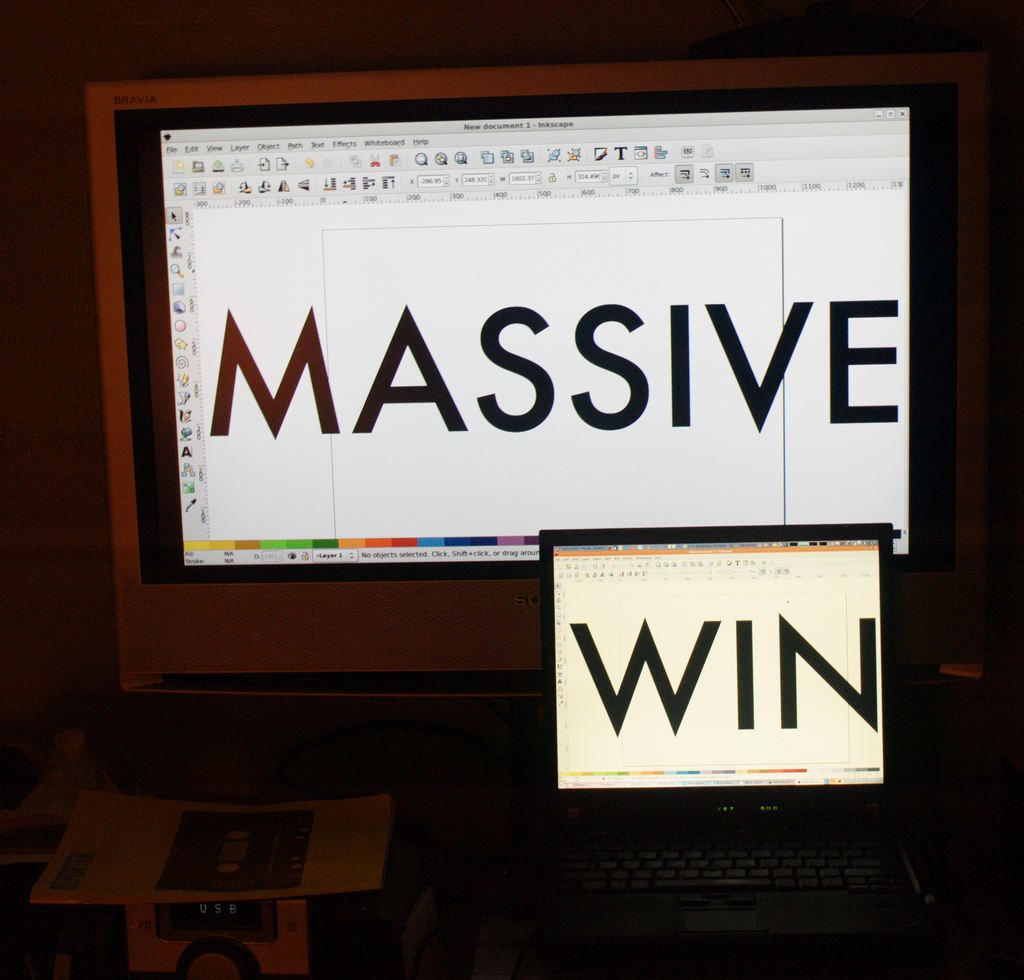
Some social media campaigns really resonate and connect with people in a meaningful way as opposed to being a passing fancy with no real impact on brand awareness or revenue. There are several instances of viral campaigns, most from the leading companies of our time, and others from lesser known brands with savvy social media managers at the helm. Here’s a discussion of three, and the components that contributed to their success.
The Shelter Pet Project
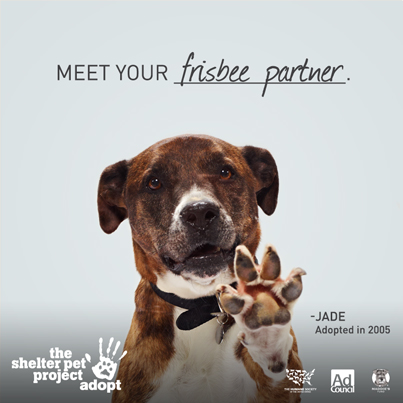
What is it?
The Shelter Pet Project is a collaboration between the Humane Society of the United States, no-kill animal shelter Maddie’s Fund, and the Ad Council. It aims to encourage the adoption of pets at animal shelters and rescue groups to lower euthanasia rates.
Last year, they embarked on a Facebook ad campaign to create awareness about shelter and rescue groups. The ads directed people to the Shelter Pet Project website, where they could search for pets available for adoption in their area.
What worked?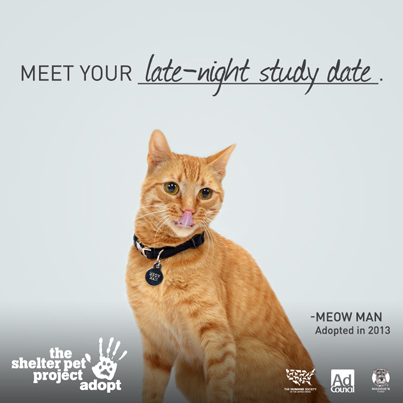

A creative approach : Internet users are often ‘banner blind’, consciously ignoring advertising clutter to get the information they seek, and rejecting the rest. Shelter Pet Project shone the spotlight on every individual dog or cat looking for a home at participating shelters. Ads featured each animal’s unique features and ‘special talent’, making them more desirable, and helping people match their preferences more easily.
A targeted approach : The campaign researched audience segments to determine who was most likely to adopt a pet. It identified newly engaged or married couples as a key segment not only ready to adopt animals but also confused about where to go and how to go about it.
A stellar landing page : The landing page you send people to is as important as the Facebook ad. The Shelter Pet Project website combines humor and a simple search functionality. It also invites engagement by asking visitors to create a shareable graphic in a guided, step-by-step process.
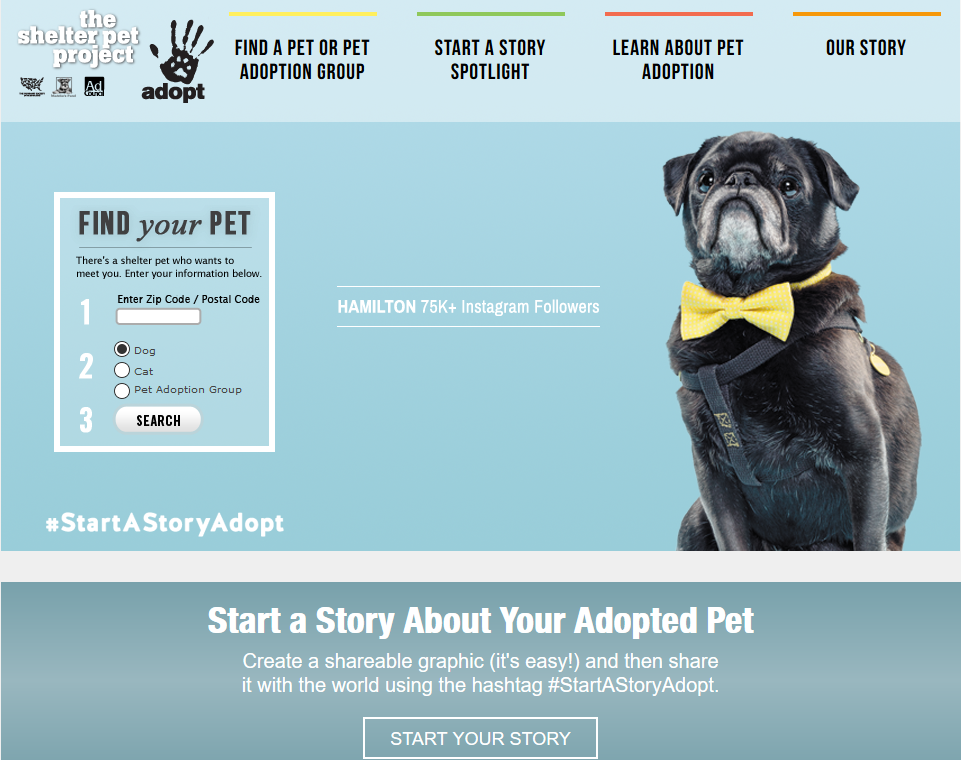
Results
Over the two month campaign duration between September and November, the ads generated 323,964 clicks to the website and reached 8,659,682 people. They also amassed 124,067 likes, 21,975 shares, and 4,610 comments. A Nielsen Brand effect study tracking the campaign found that ad recall had increased 15 per cent at the end of the campaign.
#AirWager
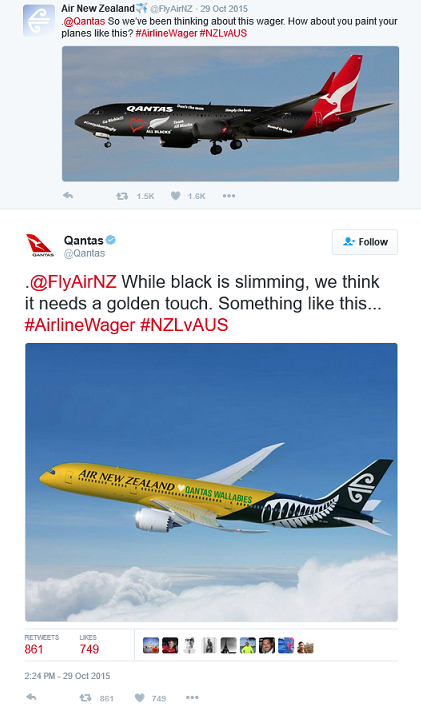
What is it?
A wager between rival airlines Qantas and Air New Zealand over the winner of the 2015 Rugby World Cup Final. The brands started the conversation on social media, and followers – most of whom were presumably rugby fans – caught on quickly, engaging in the back-and-forth between the two. The friendly exchange of words resulted in the #AirWager campaign. All of it – from the lead-up to the aftermath – played out enthusiastically on Twitter. Over Twitter, it was decided that the flight crew members of the losing team would wear rival jerseys to work.
What worked?
Capitalizing on the buzz : The Rugby World Cup is a popular sporting event, viewed by millions across the world, and particularly in Australasia, the British Isles, South Africa and France. Air New Zealand was the first to tweet the challenge by posting a digitally altered image of a Qantas plane painted in black with the slogan ‘simply the best’. Qantas responded similarly and a bet was born. The timing of the bet was crucial as it, after all involved, engaging a rival brand. Here, Air New Zealand was quick to seize the opportunity.
Sportsmanship : Everyone loves to follow a bet between two competing brands, and more so if it involves a major sporting event. It was sporting of Qantas and Air New Zealand to follow through with the bet without letting it get ugly or offensive in any way. After the All Blacks’ resounding victory, Qantas staff kept their end of the bet by donning New Zealand rugby jerseys to work for a day, which they posted to Twitter.
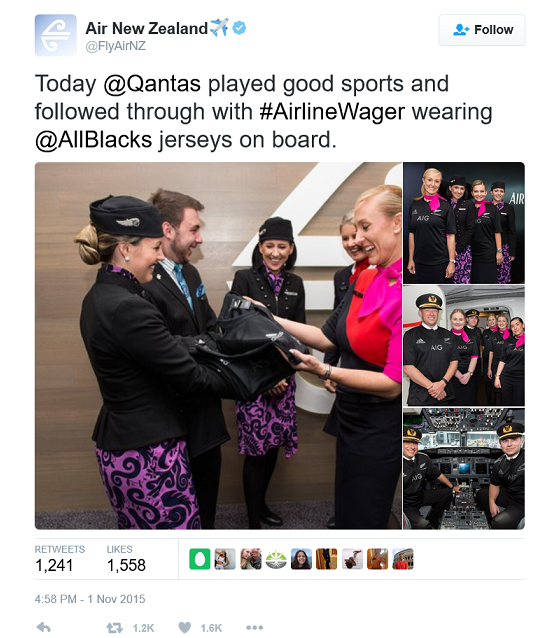
Results
Qantas won appreciation from not just Air New Zealand for their sporty attitude, but also garnered thousands of retweets with the #AirWager hashtag. The campaign ended up being a win-win for both airlines, and marked a stark contrast from the Burger King and McDonalds Twitter beef involving a similar challenge, which attracted criticism from fans.
Lay’s Do Us a Flavor
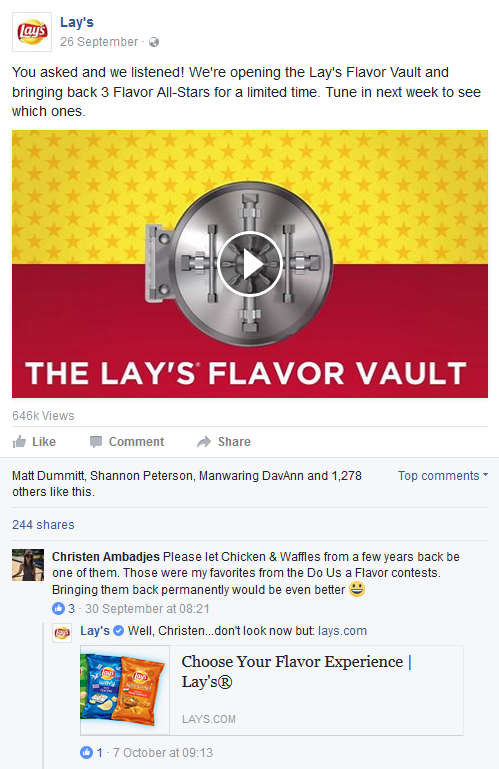
What is it?
Frito-Lay has been running its successful Do Us a Flavor campaign since 2012. The contest invites consumers to submit their ideas for a new chip flavor. The winning flavor receives a $1 million prize. Consumers get a chance to vote on new flavors. This year, the company also ran another flavor-based contest in parallel where participants stood the chance to win daily cash prizes.
What worked?
An opportunity to showcase creativity : The campaign is all about giving consumers what they want most by actively engaging them in the product development process. Lay’s packaged it into a contest – one of the best Facebook marketing tips businesses can leverage – that challenged consumers to put their creativity and taste buds to the test. The modern consumer seeks out new food experiences, and the campaign took people on a flavor exploration journey by encouraging new and unconventional flavors.
A dash of cultural diversity : From Korean Barbecue and Fiery Roasted Habanero to Magic Masala and Bacon Poutine, the campaign is a smorgasbord of culturally diverse potato chip flavors. The chance to represent their country or heritage was another pull factor that made the campaign a huge success.
New experience/Novelty : Besides the chance to win attractive prizes, the campaign allowed consumers to redefine their experience by trying out new possibilities. It expanded Lay’s reputation as the creator of deep-ridged potato chips to an innovative, consumer-focused brand selling exciting, creative and experimental snack flavors.
Results
When they first launched the campaign on Facebook, it received 4 million submissions, and contributed to a 12% increase in sales. Successive campaigns have continued attracting interest and participation.
In summary, an effective social media campaign may have one or more of the following attributes:
- Audience engagement/participation
- Rides the wave of latest trends or popular events
- High-quality visuals
- Evokes emotions
- Aims to accomplish a specific goal
- Targeted messaging
Labels:
Campaign,
social media
Subscribe to:
Comments (Atom)